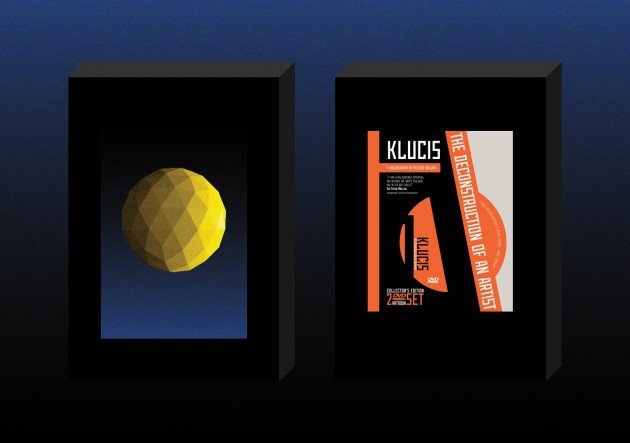
The Latvian Centre for Contemporary Art and VFS Films in partnership with the gallery Noass invite visitors to the launch event marking the publication of the anthology and catalogue Visionary Structures. From Johansons to Johansons and the release of double DVD Klucis. The Incorrect Latvian, which will take place on 27th May at 7pm at the gallery Noass, AB dam on the River Daugava.
There will be live performances from experimental musician Toms Auniņš, the author of music for Gints Gabrāns’ exhibition work Ne no kurienes (From Nowhere), and Gas of Latvia (Andris Indāns), who composed the score for the short film Visionary Structures. Artist Artūrs Riņķis has prepared a special steampunk performance programme, which will include Nekurienes ziedu pasniegšana (Presenting Flowers from Nowhere), a reading from the science fiction novel “After 5000 Years” and showing of the short film Cauri Eiropai uz BOZAR (Across Europe to BOZAR).
The collection of articles, catalogue and double DVD launch event completes two projects dedicated to Latvian avant-garde art spanning several years: the exhibition Visionary Structures. From Johansons to Johansons and the VFS produced film about Gustavs Klucis, which has been released in eight languages with added bonus materials for those interested in art, cinema and history. The documentary film Klucis. The Incorrect Latvian, directed by Pēteris Krilovs, reveals the contradictory fate of the artist through a love story and his relationship with the authorities. The box set also includes a book in English with different versions of the script and essays by international art experts.
Meanwhile the anthology and catalogue Visionary Structures. From Johansons to Johansons, which has been published in Latvian and English by the Latvian Centre for Contemporary Art, offers an overview of the creative practice of seven Latvian artists - Kārlis Johansons, Gustavs Kucis, Valdis Celms, Jānis Krievs, Artūrs Riņķis, as well Gints Gabrāns and Voldemārs Johansons. The anthology has been compiled and edited by the art historian and curator of the exhibition Ieva Astahovska, and designed by studio “Rijada”. Along with comprehensive visual and informative materials about each artist’s practice, the book also features essays from experts that situate the work of these artists within the context of particular eras and geopolitical events. The essay by Iveta Derkusova highlights the importance of Gustavs Klucis’ work within the context of early Soviet avant-garde, his search for movement and dynamics in photomontage, constructions and structural models of canvassing stands. The essay by Juris Sils traces the possible sources of inspiration behind Kārlis Johansons’ constructions that several decades later were recognised as globally significant inventions of ‘tensegrity’ and astounded the world, for instance in the constructive principles of geodesic domes by the American designer-visionary Buckminster Fuller. The encyclopaedic overview of the Latvian avant-garde art and its connections with the European art scene, written by Aija Brasliņa, contributes towards the theoretical narrative of the dense processes of the early 20th century avant-garde. The essays about innovative design, kinetic and environmental art of the 1970s Latvia, written by the researchers David Crowley, Margareta Tillberga and Iliana Veinberga, analyse the kinetic objects, environmental installations, visionary proposals and the so-called kinetic light painting by Valdis Celms, Jānis Krievs and Artūrs Riņķis in relation to the Soviet modernisation and its attendant discourse of ‘technical aesthetics’. Domenico Quaranta and Ainārs Kamoliņš concentrate on interpreting the practice of Gints Gabrāns and Voldemārs Johansons by examining their work as an interrelationship between art and science. The visionary complexity of all three generations has been analysed by the philosopher Jānis Taurens – how the radical ideas of the early 20th century avant-garde amalgamated with the totalitarian political reality, how the experiments of the 1970s co-existed with the instrumental rationality of the Soviet authorities, how the relationship of art and science in the 21st century oscillates between artistic research and scientific aesthetisation.
The anthology and catalogue have been intended as a contextual material to accompany the exhibition, which followed the development of avant-garde art through the work of three different generations of artists in the 20th and 21st century, from constructivism to the experiments in art and science synergy. The exhibition opened last year from 3rd July until 6th August at the National Library of Latvia as part of the European Capital of Culture Programme Riga 2014 and travelled to BOZAR, Centre for Fine Arts, in Brussels, Belgium, from 12th February until the end of May under the cultural programme of the Latvian Presidency of the Council of the European Union.
The publication of anthology and catalogue Visionary Structures. From Johansons to Johansons and the release of the special edition double DVD Klucis. The Incorrect Latvian has been generously supported by the Latvian Presidency of the Council of the European Union, as well as the State Culture Capital Foundation.